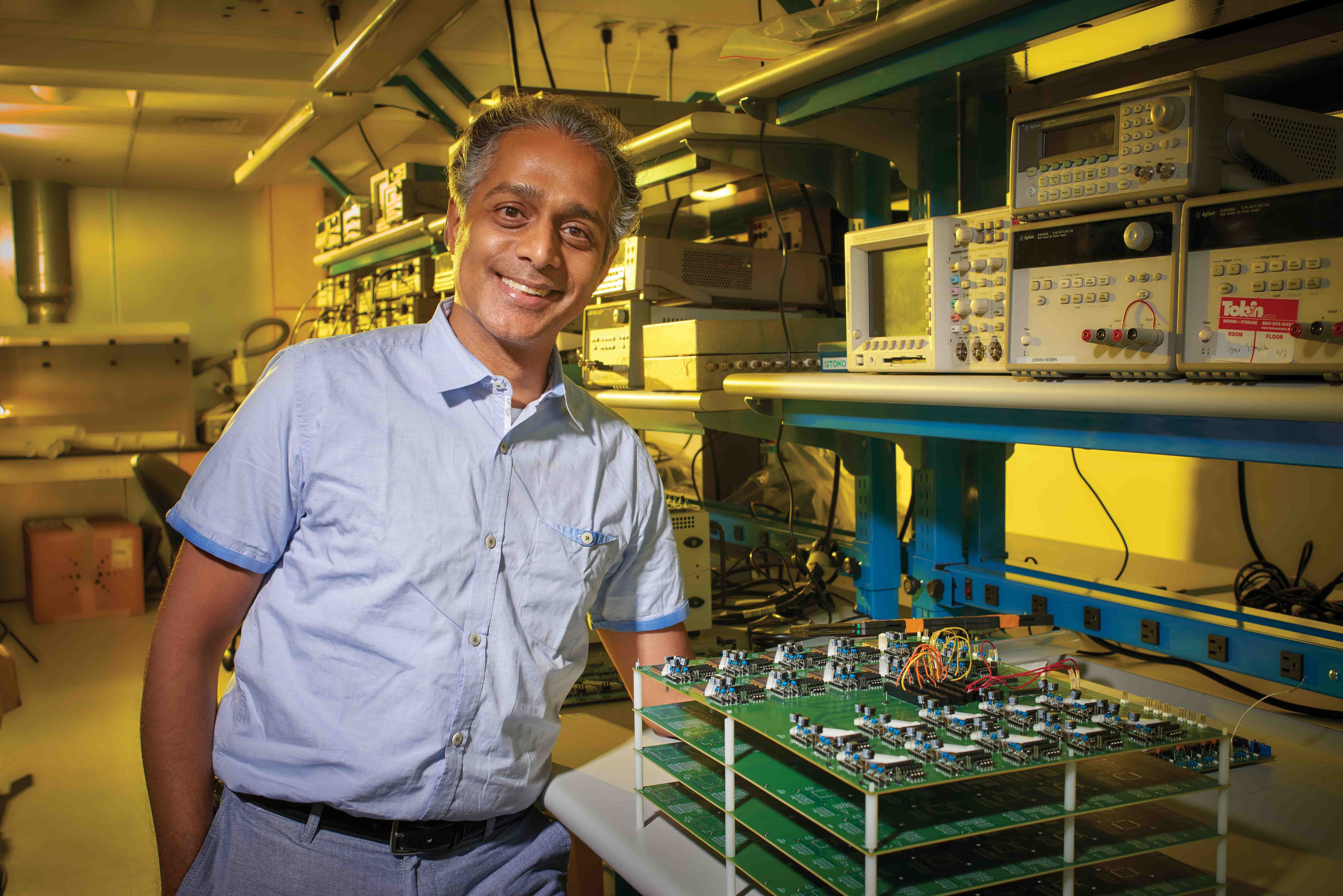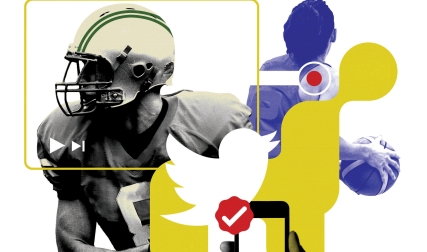Human brains, like supercomputers, can perform quadrillions of operations per second. But a supercomputer guzzles a lot more energy, enough to power hundreds of houses. A brain, on the other hand, runs on the energy equivalent of an electric shaver.
“Cells are the most energy-efficient computers ever built,” says Rahul Sarpeshkar, an inventor and multifaceted professor—of engineering, physics, microbiology and immunology, and physiology and neurobiology—who arrived at Dartmouth two years ago after working at the Massachusetts Institute of Technology for 16 years. With him came his work on mimicking the way the human body computes.
Sarpeshkar has built low-power and battery-free implants that aid the deaf and paralyzed. He has turned a cell into a calculator. He’s working on an ultra-fast supercomputer that can test drugs virtually and he is figuring out how to reprogram immune cells to fight cancer.
At Dartmouth, Sarpeshkar aims to build a new kind of supercomputer by filling a room or building with millions of his cell-inspired computer chips. Together the chips would simulate the actions of all the cells in an organ, such as a liver, and eventually an entire body. This would allow scientists to test drugs in a computer rather than on patients or animals. “We would be able to google medical cures,” Sarpeshkar says. Though this vision may take 10 years to implement, “it’s not science fiction,” he says. “I’ve laid the foundation already. A lot of the stuff is now way past the risk stage.”
Sarpeshkar is also using circuit design principles to repurpose living cells. Genetic engineering has been around for decades, but most examples are simple: Insert one gene into a cell to make a useful protein, such as insulin. Sarpeshkar and others want to insert multiple genes that will work together to accomplish more sophisticated tasks, such as sensing and attacking tumors. “In biology, if you can engineer the cell, you can do anything,” Sarpeshkar says.
Digital thinking has colored much of the work in this area, but complex and bulky digital circuits quickly drain energy. Sarpeshkar believes an analog approach is needed. To prove the point, he showed that he could turn a cell into a calculator by inserting just two proteins—one that ramps up production of a fluorescent molecule and one that dampens levels. This is sufficient to allow the cell to add, subtract, multiply, divide and even take square roots. An equivalent digital solution would take about 130 genetic switches.
Sarpeshkar is collaborating with Edward Usherwood, professor of immunology and microbiology at the Geisel School of Medicine, to reengineer immune cells to fight cancer. One of the most promising new cancer treatments involves taking a patient’s own T cells and genetically engineering them so they can better recognize and kill cancer cells. The therapy has dramatically prolonged survival in some patients with aggressive blood cancers. One major problem, however, is that the cells don’t last long in the body. Sarpeshkar and Usherwood plan to introduce new genetic circuits that improve the cells’ longevity.
Usherwood says that Sarpeshkar has become a “focal point” around which larger collaborations are forming across engineering, computer science, biochemistry and biology at Dartmouth. “Rahul has big, ambitious visions. He wants to build the program at Dartmouth into something that is of international stature,” says Usherwood.
Sarpeshkar showed that he could turn a cell into a calculator by inserting just two proteins to allow the cell to add, subtract, multiply, divide and even take square roots.
Sarpeshkar was interested in science, math and engineering from an early age. As a child he tinkered with chemistry and electronics kits and solved math problems for fun. “I took naturally to science and numbers. It was born in me,” he says. As an undergraduate at MIT he studied physics and electrical engineering.
Sarpeshkar’s dive into biomedicine began as a Ph.D. student at the California Institute of Technology, where he studied under computing legend Carver Mead. By 1990 Mead had pioneered the concept of “neuromorphic computing”—building computer chips inspired by how the brain and nervous system work. “Carver taught me that intuition, imagination and common sense are more important than formal education,” Sarpeshkar says. “He also opened my eyes to how amazing biology is.”
Biology’s power budgets are incredibly low compared with computers. The key is that biology uses a combination of analog and digital computing, whereas computers are almost exclusively digital. To understand the tradeoffs, consider how one might add graded lighting to a room: The analog solution is to use a dimmer switch. A digital solution is to install 10 light bulbs, each with a separate on/off switch. The digital setup offers extreme precision—turning on five bulbs gives the exact same lighting each time, whereas sliding a dimmer is inconsistent. But the analog setup saves energy, space, time and parts.
The inherent imprecision of analog computing has led most modern engineers to avoid it, but Sarpeshkar has made it a cornerstone of his work. He has succeeded in making electronics both efficient and reliable by using the right mix of analog and digital circuits, as well as by building in feedback loops and error correction—other tricks used by nature.
Keeping energy requirements low is particularly important for electronic devices implanted in the body, such as heart pacemakers. The batteries in these devices need to last as long as possible, since swapping them out requires surgery. Implantable batteries also can’t get too hot, or they risk cooking surrounding cells and tissues.
After joining the faculty at MIT in 1999, Sarpeshkar set out to build a better cochlear implant. Cochlear implants restore hearing in the deaf by taking over the job of a damaged inner ear—converting sound waves into electrical pulses the brain can recognize. Most cochlear implants digitize sound right away, but Sarpeshkar noticed that the ear first processes sound in an analog form, which it later digitizes. Sarpeshkar’s team built a cochlear implant that, by delaying digitization, outperforms available devices for listening to music and hearing in noisy environments but requires just one-20th the energy—250 microwatts.
Sarpeshkar’s lab also worked on brain-machine interfaces. These devices have allowed a handful of patients with quadriplegia to control a prosthetic arm with their thoughts. When people are paralyzed, the electrical signals in their brains that tell their arms and legs to move are stranded. Using implantable brain chips, scientists can extract this neural chatter, transmit it to a computer and figure out a person’s intended movements. The systems are bulky: Signals are fed to an external computer through wires sticking out of the skull. Sarpeshkar’s team has reduced the energy needs and size of the computer to fit on an implantable chip, and they’ve created a wireless link for getting signals in and out of the brain. The system has yet to be fully tested on humans.

They also figured out how to power the chip without a battery. “I asked, ‘How do cells power themselves?’ ” Sarpeshkar says. “That’s when I realized that we shouldn’t be working with batteries to power things, we should be working with glucose.” His team fashioned a fuel cell that can extract energy directly from glucose present in the brain. Since the fuel cell has an unlimited supply of energy, it never needs to be replaced.
Sarpeshkar’s innovations could be used in many other medical implants in development, including devices that restore vision to the blind, return muscle movement to stroke patients and continuously monitor blood pressure. “Rahul was doing low-power biomedical implants when very few people were doing it,” says Soumyajit Mandal, who was a doctoral student with Sarpeshkar at MIT in the 2000s and is now an assistant professor at Case Western Reserve University. “Now the field has exploded. He set the stage for a lot of what is happening.”
Indeed. The glucose fuel cell was named one of Scientific American’s 10 “World Changing Ideas” for 2012. Sarpeshkar, who holds 36 patents for his inventions, is working on commercializing his devices to bring them to patients. His 2010 book, Ultra Low Power Bioelectronics (Cambridge University Press), lays out general principles for low-power electronics that could even have applications outside of biomedicine, such as for making low-power cars.
While writing his book—which, at 890 pages, took two and a half years to complete—Sarpeshkar had an epiphany. He noticed striking parallels between living cells and analog computer chips. The same mathematical equations that describe the flow of DNA, RNA and proteins through a cell also describe the flow of electricity through analog circuits. Plus, biological molecules have electronic counterparts—a protein that represses gene expression is similar to an electronic component that dampens current flow. This means that one can mimic a cell in a computer chip or, conversely, treat a cell like a programmable computer.
In 2010 Sarpeshkar took a two-week crash course at Smith College to learn hands-on lab work, such as how to clone genes, run gels and sequence DNA. “I knew a lot of theory, but I had never done any pipetting or real stuff before,” he says. Pipettes are precise chemical droppers used to measure and transfer liquids. Pipetting turned out to be enjoyable, Sarpeshkar says. “There’s almost a yoga technique to it: You take the stuff in with a breath, and then pipette it out as you breathe out.” When he returned to MIT, he converted half of his electronics lab into a wet lab for working with living cells.
During the next six years Sarpeshkar built prototypes of cell-inspired computer chips with the help of Sung Sik Woo, a doctoral student at MIT who continued to work with Sarpeshkar at Dartmouth until recently. Woo’s admiration for Sarpeshkar is evident. “Even though he is in a senior position, he’s always trying to learn new things,” Woo says. “He emphasizes the importance of pursuing high-hanging fruit, not just doing something that’s trivial.”
The cell-inspired computer chips have a hybrid analog/digital design that allows Sarpeshkar to do “lightning-fast” computing. The chips can already simulate the behavior of a cell 20,000 times faster than available technology—and Sarpeshkar believes that a million-fold speed-up is possible. Simulating everything that goes on in one cell, without taking any shortcuts, would take 12 years on an available supercomputer. “We’re planning to do it in seven minutes,” he says.
One thing that's very unusual about Rahul is the ease with which he moves between engineering, physics and biology,” says Joseph Helble, dean of Thayer School of Engineering. “He’s able to bring these things together in ways that are extraordinary and that I’ve not seen in many other individuals.”
Sarpeshkar’s commitment to interdisciplinary research is one of the things that drew him to Dartmouth. He will head Dartmouth’s first cluster initiative—the William H. Neukom Academic Cluster in Computational Science. The cluster initiative brings together interdisciplinary faculty teams to solve urgent global problems. “Rahul is a cluster unto himself, the way he spans different perspectives, methodologies and worldviews,” says Provost Carolyn Dever. “He understands that this is a place where he can succeed because he can go across lines of discipline and school so easily.” (The Neukom cluster has just hired a second professor, and when it hires a third it will be “fully launched,” according to Sarpeshkar. “My research is being leveraged in an immune-engineering center that cluster members will actively participate in.”)
Sarpeshkar encourages students to get out of their disciplinary silos. Orville and Wilbur Wright, whom he idolizes, had no formal training or degrees—no disciplinary labels or boxes—and this freed the brothers to think outside of the box, he says. “You have to be a bigger thinker than your petty department or your petty school or your petty discipline.” He is developing a course for undergrads and graduate students for next year that will be called “Biological Circuit Engineering” and cross-listed in biology, physics and engineering. In his lab at the medical school, students from the life sciences and technical fields will work together in the adjoining wet and dry spaces.
Outside of the classroom Sarpeshkar enjoys swimming, yoga, hiking, skiing, detective fiction, James Bond movies, playing with his 4-year-old son—who delights in running around the Green—and exploring the Hanover area.
“He always says: ‘Health is first, love is second, science is third,’ ” says Woo. When Woo had to have surgery as a doctoral student, Sarpeshkar told him to stay out of the lab and focus on recovery. “He wasn’t just a boss who wanted me to publish papers for him. He was different.”
Since arriving on campus Sarpeshkar has also ventured into quantum physics and the mysterious behavior of subatomic particles such as electrons and protons. “I recently got an important insight into how to understand quantum physics by reformulating it through the lens of analog circuits and analog computation. When this understanding clicked, it was a moment of great joy,” Sarpeshkar says.
“I’ve always followed my nose and my heart,” he adds. “And every single time I do this, I end up doing something amazing.”
Kristin (Cobb) Sainani is an associate professor of health research and policy at Stanford University. She writes about health and science.




